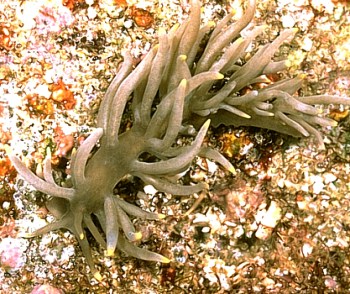
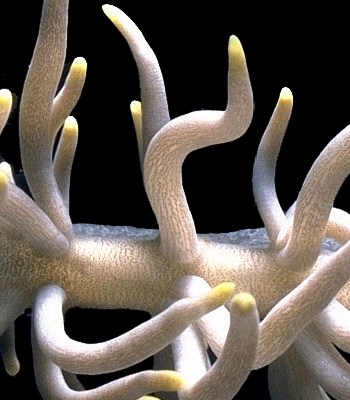
Phyllodesmium briareum
(Bergh, 1896)
Order: NUDIBRANCHIA
Suborder: AEOLIDINA
Family: Glaucidae
DISTRIBUTION
Known from Tropical western Pacific and Indonesian Archipelago.
PHOTO
UPPER: southern end of Sek Island, Madang, March 1987. [20mm long preserved - WAM391-87]. PHOTO: F.E. Wells,
LOWER: Closeup of animals showing the development of ducts in the body wall and cerata to nurture zooxanthellae, which can be seen as lines of brown specks. Animal 25mm long alive, Tambuli Beach, Mactan Is, Cebu, 20m, March 1983, on Solenopodium stelleri (Fam: Briareidae) Philippines, March 1983. PHOTO: B.E.Picton
Phyllodesmium briareum, like other species of Phyllodesmium, feeds on soft corals and is very well camouflaged when crawling over or nestled between the polyps of the doft coral it is feeding on. It is reported to feed on a number of species of briareid soft coral including Solenopodium stelleri and Briareum stecheri (sensu MacFadyen, 1936). It is also reported from Pachyclavularia violacea a mat forming soft coral with purplish trunks and greenish brown polyps (See Rie Nakano's message below).
The name briareus was apparently given to it by Bergh because of its association with the soft coral Briareum.
As you will see from the Bernard Picton's photo on the right, P. briareum is one of the species of Phyllodesmium which has a symbiotic relationship with zooxanthella. The rows of brown specks in the photo are one-celled plants [zooxanthellae] which are nurtured in specialised ducts of the aeolid's digestive gland, where they continue to grow, reproduce and photosynthesise, providing nutrients for the aeolid.
Reference:
• Rudman, W.B. (1991) Further studies on the taxonomy and biology of the octocoral-feeding genus Phyllodesmium Ehrenberg, 1831 (Nudibranchia: Aeolidoidea). Journal of Molluscan Studies, 57(2): 167-203.
Rudman, W.B., 1999 (November 25) Phyllodesmium briareum (Bergh, 1896). [In] Sea Slug Forum. Australian Museum, Sydney. Available from http://www.seaslugforum.net/find/phylbria
Related messages
Phyllodesmium briareum from the Philippines
August 14, 2008
From: Marcel Tanke
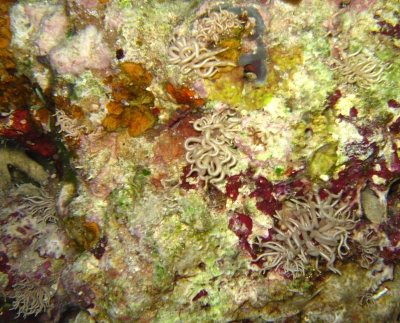
Dear Bill,
In Cebu-Moalboal we found in 2 separate locations, a rather large aggregation of Phyllodesmium briareum. In both cases they were on top of a thin layer of sponge (?) that covered the reef. There were maybe several hundreds of them. The first picture attached alone shows some 20 P. briareum already.
We watched- and took pictures for several minutes. We did not see one that moved, not even a little bit. I tried to make them move by waving my hand and move some water over them. They were stuck very strongly to the sponge (?), no movement at all. We also saw that several had their cerata 'bent' towards their mantle. I read somewhere on your forum (can't find it anymore) that you referred to it as 'sleeping'. Any other / additional information why they are doing this?
Locality: Cebu Island, Moalboal, 10-15 meter, Philippines, 28 April 2008. Length: 4mm - 3 cm. Photographer: Marcel Tanke.
Thanks and regards,
Marcel
marceltanke@cs.com
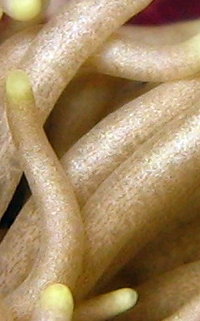
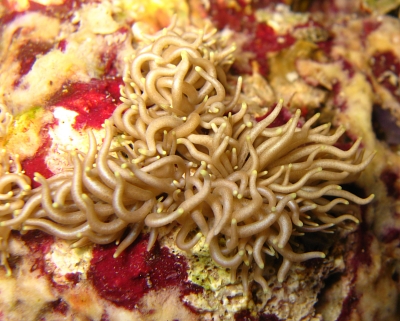
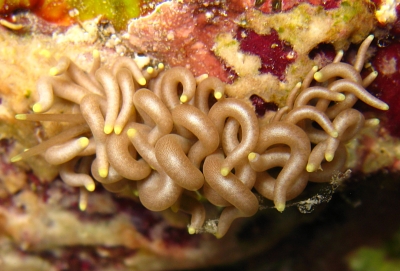
Dear Marcel,
I did a quick search on the Forum and couldn't find my reference to 'sleeping' but it worth remembering that this is a solar-powered sea slug, so it needs to ensure that the plant cells in its body get plenty of sunlight so they can photosynthesise and provide it with food. I have included a close-up to show the lines of brown specks in the cerata, which are the clusters of microscopic plants [zooxanthellae] living in ducts of the digestive gland. This species gets it zooxanthellae by eating a soft coral which often has a dark purple colour form. I can't see any sign of its food in your photo so its possible the Phyllodesmium have completely eaten out the soft coral colony and are now acting as plants by 'sunning' themselves in an unshaded place. If you look through some of the earlier messages on the Forum about this species, you will find they are often found in large aggregations. I wouldn't be surprised if this indicates that they have either direct development or an abbreviated development, which would mean all the hatchlings from one egg ribbon grow up together in the same area, presumably on one soft coral colony.
Interestingly the other major group of solar-powered slugs - the sacoglossans which keep chloroplasts alive in their tissues - have members which also laze about in the sunlight, much for the same reason.
Best wishes,
Bill Rudman
Phyllodesmium briareum? from Vietnam
March 6, 2008
From: Hua Thai Tuyen
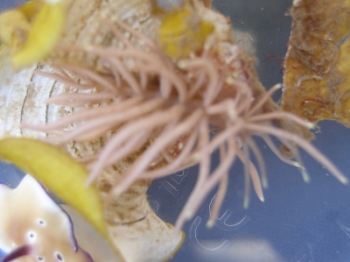
I need someone to help identify this one? Is it Phyllodesmium briareum?
Locality: Cu Lao Cham Island, 5 m, Vietnam, April 2004, coral reef. Length: 60 mm
Hua Thai Tuyen
hthaituyen@yahoo.com
Hua Thai Tuyen, 2008 (Mar 6) Phyllodesmium briareum? from Vietnam. [Message in] Sea Slug Forum. Australian Museum, Sydney. Available from http://www.seaslugforum.net/find/21423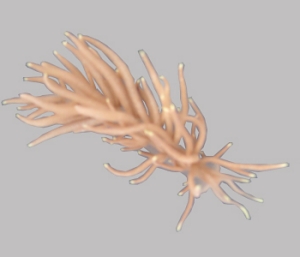
Dear Tuyen,
Although I can't see any detail - in particular whether the brown spots of the zooxanthellae clusters form longitudinal lines on the cerata [see P. briareum Fact Sheet] I think we can be fairly confident from the general shape and colour that this is P. briareum.
Best wishes,
Bill Rudman
Phyllodesmium briareum from Lembeh
February 17, 2007
From: Bruce Wight
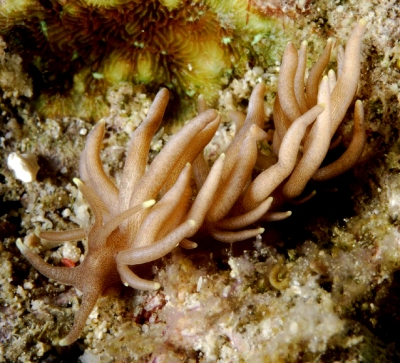
Dear Bill
I spent a week in Lembeh in mid November, and saw many branchs that were new to me. I have sent photos of three species of Phyllodesmium, including this one of P. briareum that I thought would add to the Forum.
Locality: Lembeh Strait, 25-45 Feet, Sulawesi, Indonesia, Celebes Sea, November 2006, Crawling on reef . Length: 1-1 1/2 Inches. Photographer: Bruce Wight.
Thanks
Bruce Wight
bruce.c.wight@boeing.com
Wight, B.C., 2007 (Feb 17) Phyllodesmium briareum from Lembeh. [Message in] Sea Slug Forum. Australian Museum, Sydney. Available from http://www.seaslugforum.net/find/19339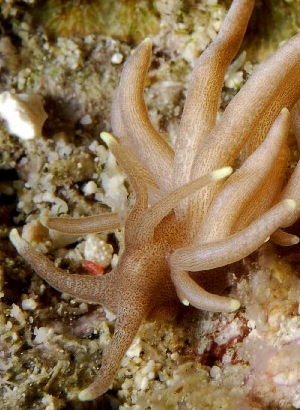
Dear Bruce,
Its good to get more photos of these fascinating aeolids. As you can see in the enlargement alongside, this is one of the species in which the brown specks [zooxanthellae] are arranged in longitudinal lines along the length of the cerata and most of the body. Internally that means there are long thin tubes of the digestive gland running along the inside of the skin, providing a 'nursery' where the zooxanthellae can be bathed in sunlight and get the nutrients they require to photosynthesise.
Best wishes,
Bill Rudman
Phyllodesmium briareum from Sulawesi
November 30, 2006
From: Mike Krampf
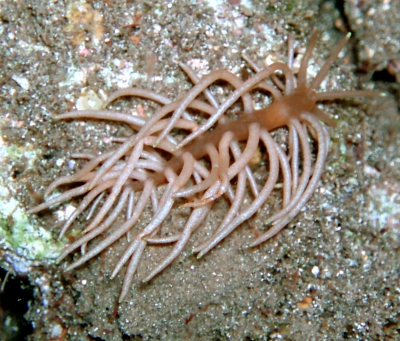
Dear Bill
I thought I'd share this picture of a Phyllodesmium briareum. It was taken on a night dive.
Locality: Dive Site - Pehe off Siau Island, 30 ft, Sulawesi, Indonesia, Celebes Sea, 23 October 2006, Fringing reef. Length: 2 cm. Photographer: Mike Krampf.
Mike
mtkrampf@yahoo.com
Krampf, M., 2006 (Nov 30) Phyllodesmium briareum from Sulawesi. [Message in] Sea Slug Forum. Australian Museum, Sydney. Available from http://www.seaslugforum.net/find/18658Dear Mike,
Thanks for the photo. It looks quite strange crawling off its food.
Best wishes,
Bill Rudman
Re: Phyllodesmium briareum from Singapore
November 27, 2006
From: Toh Chay Hoon
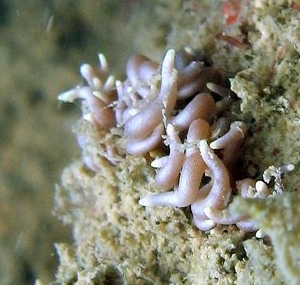
Concerning message #16686:
Dear Bill,
Here's an update which I think is a Phyllodesmium briareum again from Singapore.
Locality: Pulau Salu, 5m, Singapore, Singapore (Southern Island), 19 November 2006, Substrate/Coral Rubbles. Length: 20mm. Photographer: Chay Hoon.
Toh Chay Hoon
sonnenflower@gmail.com
Toh Chay Hoon, 2006 (Nov 27) Re: Phyllodesmium briareum from Singapore. [Message in] Sea Slug Forum. Australian Museum, Sydney. Available from http://www.seaslugforum.net/find/18443Dear CH,
Yes this is P. briareum
Best wishes,
Bill Rudman
Phyllodesmium briareum from Singapore
May 27, 2006
From: Toh Chay Hoon
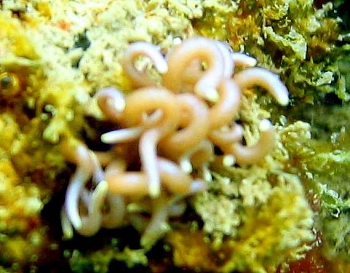
Dear Bill,
Sighted this which looks similar to the nudibranch, Phyllodesmium briareum. Please kindly assist if you know what this is?
Locality: Pulau Hantu (West), Singapore, 3 m, Singapore , Singapore (Southern Islands) , 14 May 2006, Coral/Coral rubbles. Length: 15 mm. Photographer: Chay Hoon.
Thanks & Regards,
CH
sonnenflower@gmail.com
Toh Chay Hoon, 2006 (May 27) Phyllodesmium briareum from Singapore. [Message in] Sea Slug Forum. Australian Museum, Sydney. Available from http://www.seaslugforum.net/find/16686Dear CH,
Even though a bit difficult to see, this has the characteristic shape of Phyllodesmium briareum.
Best wishes,
Bill Rudman
Re: Phyllodesmium briareum in aquarium shipment
March 1, 2006
From: Michael Mrutzek
Concerning message #15946:
Hello Bill
Of course I don't "kill" them, because they are wonderful Slugs.
I start with ONE and now I have four of the in my tanks.
Also I will study them, see how many they will eat and in what time, so may be other users will be able to use this slug in their tanks, when Pachyclavularia spp. grow too fast.
Thanx for Help:-))
Michael
MIchael@meeresaquaristik.de
Mrutzek, M., 2006 (Mar 1) Re: Phyllodesmium briareum in aquarium shipment. [Message in] Sea Slug Forum. Australian Museum, Sydney. Available from http://www.seaslugforum.net/find/15981Dear Michael,
Look forward to your reports. It's nice to get a 'good news' story about keeping opisthobranchs in tanks.
Best wishes,
Bill Rudman
Phyllodesmium briareum in aquarium shipment
February 27, 2006
From: Michael Mrutzek
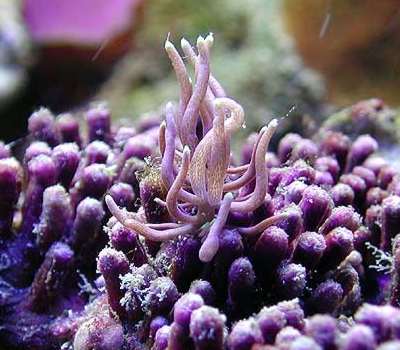
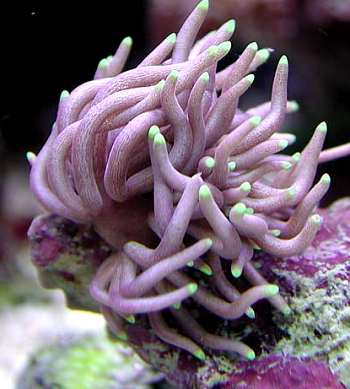
Dear Bill,
This one is coming from Jakarta/Indonesia with imported aquarium animals in Nov. 2005. Photographer: Michael Mrutzek
I find them on this Stolonifera and this slug is eating the colony.
I cant find a NAME for this. Can you help?
Regards,
Michael
Michael@meeresaquaristik.de
Mrutzek, M., 2006 (Feb 27) Phyllodesmium briareum in aquarium shipment. [Message in] Sea Slug Forum. Australian Museum, Sydney. Available from http://www.seaslugforum.net/find/15946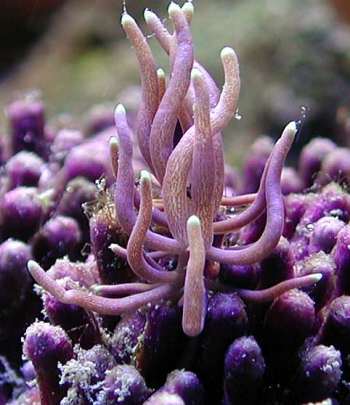
Dear Michael,
This is an interesting find. It is Phyllodesmium briareum which appears to feeds on a number of soft corals, including Pachyclavularia violacea, which I suspect is the one your animals are on. The brown specks arranged in lines down the cerata, are little clusters of zooxanthellae, whch are microscopic plants like those in hard corals. Have a look at the Fact Sheets on solar-powered slugs for further information. I would suspect, that if you have plant friendly lights in your aquarium, the Phyllodesmium will be able to obtain nutrition from the zooxanthellae, so won't need to eat your soft coral full time.
I hope you are willing to take the risk, as these are fascinating animals, and it would be a shame to destroy them just to protect the soft coral.
Best wishes,
Bill Rudman
Phyllodesmium briareum from Malaysia
October 8, 2005
From: Ho Wei Kwok Alvin
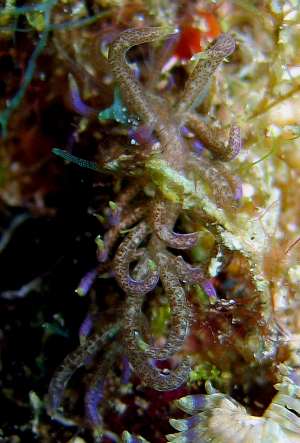
Hi Bill,
Need your expertise again. Was taking pictures of a Pteraeolidia ianthina when I noticed another nudibranch beside it. I'm not too sure which species is this exactly though i'm quite sure it is a Phyllodesimium.
Locality: Turtle House, Pulau Lang, West Malaysia, South China Sea. Depth: 10-15 m. Length: 10-20 mm. 01 October 2005. Sandy bottom, Coral outcrops. Photographer: Alvin Ho
Thanks and regards,
Alvin
howeikwok@hotmail.com
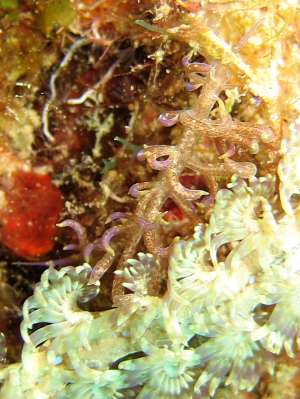
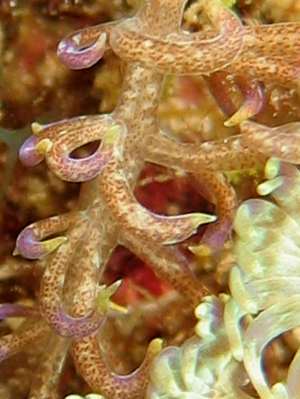
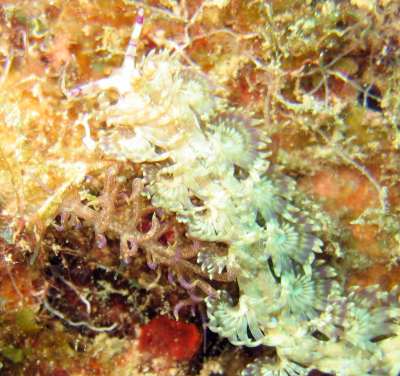
Dear Alvin,
Yes ot is a Phyllodesmium. It is Phyllodesmium briareum, which is almost certainly one of the solar-powered species. The lines of brown patches you can see on the cerata are little clumps of the unicellular zooxanthellae it keeps alive in its body.
Best wishes,
Bill Rudman
Phyllodesmium briareum from Vanuatu
March 10, 2003
From: Vinka Stenhouse
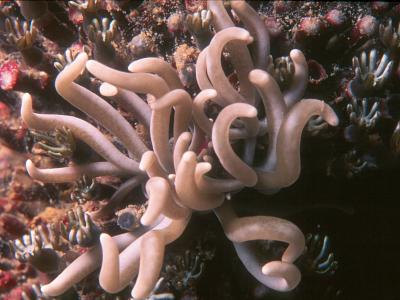
Hello Bill
This nudibranch was seen in Santo, Vanuatu over a 5 week period on the same patch of soft coral and it then disappeared/moved on. Intertidal. Is it a Phyllodesmium magnum?
Photo credit: James Stenhouse
Regards
Vinka
vinkas@oceanaphotography.com
Dear Vinka,
This is Phyllodesmium briareum . I am pretty sure the soft coral it is on is a species of Pachyclavularia, on which it is known to feed.
Bill Rudman
Phyllodesmium briareum from Malaysia
July 14, 2002
From: Richard Houghton
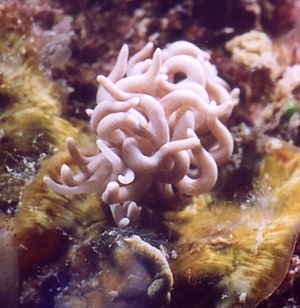
Bill,
Here is another nudibranch found off Pulau Aur, Malaysia. Found in 5 metres of water on it's own. 35mm in length. June 2002.
Happy diving,
Rich
richard_houghton@hotmail.com
Houghton, R., 2002 (Jul 14) Phyllodesmium briareum from Malaysia. [Message in] Sea Slug Forum. Australian Museum, Sydney. Available from http://www.seaslugforum.net/find/7492Dear Rich,
This is Phyllodesmium briareum, which from recent messages seems to have been quite common recently in this part of Malaysia. I can't identify what it is on but if you look at some of the other information on this page you will see it seems to be a specialised soft coral feeder.
Best wishes,
Bill Rudman
Phyllodesmium briareum from Papua New Guinea
July 8, 2002
From: John Chuk
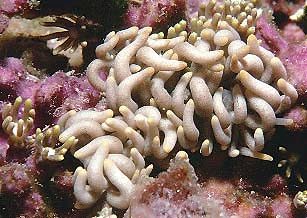
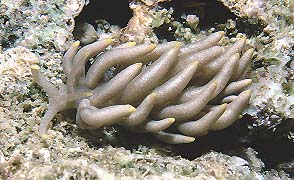
Dear Bill,
Here are images of Phyllodesmium briareum found at Pig Island, Madang, Papua New Guinea on August 12, 1996. I counted 23 specimens on a colony of the soft coral Pachyclavularia violacea that was found on a reef flat at a depth of 2m. P. briareum was also found on other nearby colonies of the soft coral.
The first image is an in situ shot of several specimens on the soft coral. The second image is of a specimen 17mm in length removed from the soft coral. This specimen appears fairly well stocked with zooxanthellae.
Best wishes,
John.
jchuk@giant.net.au
Chuk, J., 2002 (Jul 8) Phyllodesmium briareum from Papua New Guinea. [Message in] Sea Slug Forum. Australian Museum, Sydney. Available from http://www.seaslugforum.net/find/7413Thanks John,
Bill Rudman
Phyllodesmium briareum from west Malaysia
July 2, 2002
From: Kheong Sann Chan
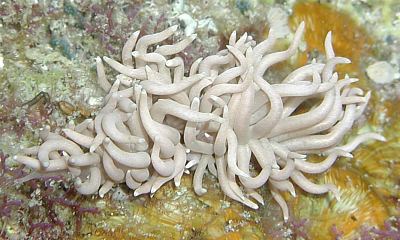
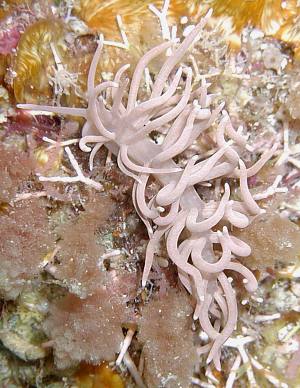
Here are some more photos from Pulau Dayang off the east coast of west Malaysia.
This one I didn't know was a nudi, but the Dive Master was pointing it out excitedly, so I shot it anyway, and found out it was a nudi later. What's its name? It's also around 5cm.
Location: Pulau Dayang, Pinang, Malaysia
Date: 8 June 2002, 1800hrs
Depth: 7m
Kheong
kschan@mail.dsi.nus.edu.sg
Chan, K.S., 2002 (Jul 2) Phyllodesmium briareum from west Malaysia. [Message in] Sea Slug Forum. Australian Museum, Sydney. Available from http://www.seaslugforum.net/find/7217Dear Kheong,
This is Phyllodesmium briareum. Have a look at the Fact Sheet and recent messages for information on this fascinating animal. It is apparently not uncommon in west Malaysia.
Cheers,
Bill Rudman
Phyllodesmium briareum from Malaysia
June 30, 2002
From: Kenneth Leong
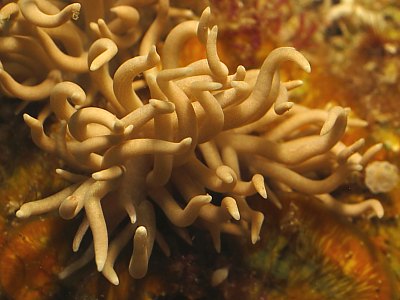
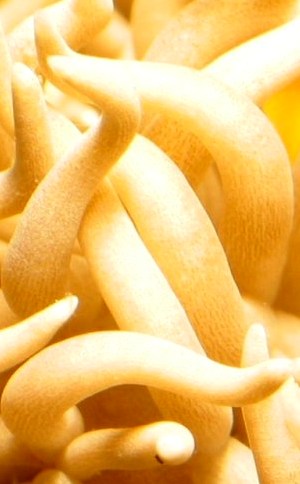
Hi Dr Rudman,
Sometime ago my dive buddy told me of this website and suggested I upload some of my nudi shots. So, on a recent dive we spotted this whitish creature which is about one and a half inch in length, crawling along some corals. I am wondering if you know what this is?
The dive was at Pulau around Dayang Island. West Malaysia. It was around 5pm at a depth of ten meters. The surroundings were mainly hard corals.
Kenneth.
kenleong@pacific.net.sg
Leong, K., 2002 (Jun 30) Phyllodesmium briareum from Malaysia. [Message in] Sea Slug Forum. Australian Museum, Sydney. Available from http://www.seaslugforum.net/find/7381Dear Ken,
This is an aeolid nudibranch called Phyllodesmium briareum. Species of Phyllodesmium feed on soft corals, and this species is no exception. Have a look at the Fact Sheet for this species, and at the other messages about it, for further information on its biology. I have included a closeup of one of your photos to show the brown lines down the cerata. The brown specks are microscopic algal cells [zooxanthellae] which provide the slug with energy. See the pages on Solar powered Slugs for more information on these amazing animals.
Best wishes,
Bill Rudman
Phyllodesmium from Pulau Aur, Malaysia
June 26, 2002
From: Barbara Phua
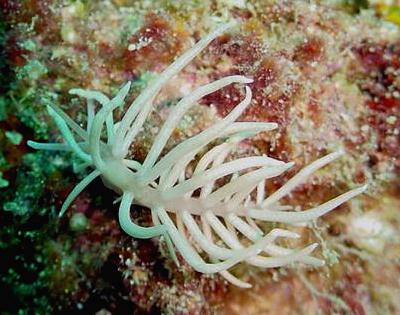
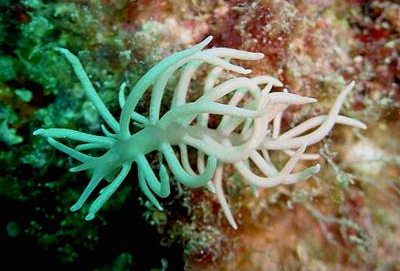
Hi Bill,
I spotted this nudibranch in the waters off Teluk Jawa, Pulau Aur, west Malaysia last weekend. It was the first time I saw this species of nudibranch there. Can you help me to ID it?
Barbara
babalapan@hotmail.com
Phua, B., 2002 (Jun 26) Phyllodesmium from Pulau Aur, Malaysia. [Message in] Sea Slug Forum. Australian Museum, Sydney. Available from http://www.seaslugforum.net/find/7338Dear Barbara,
I am pretty sure this is Phyllodesmium briareum. If you look at the Fact Sheet on this species you will see that it is 'solar-powered' and keeps brown zooxanthellae in its cerata and the skin of its body. The zooxanthellae give it is brown colour. Eventually the zooxanthellae in the skin die and can only be replaced by eating the right soft coral. Until they feed again, the nudibranch can become quite pale, like yours are. So I suspect your photos are of a 'hungry'Phyllodesmium briareum.
Best wishes,
Bill Rudman
Re: Phyllodesmium briareum eggs
May 27, 2001
From: Mary Jane Adams
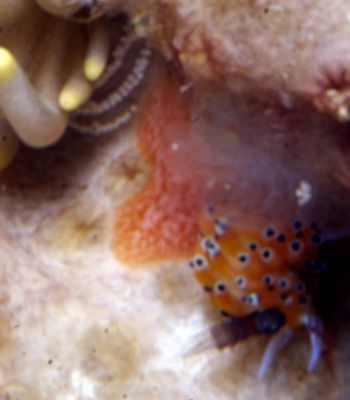
Hi Bill,
Concerning your question about an egg photo, I only have one shot of the Phyllodesmium briareum with eggs. I enlarged the image and measured the eggs. They get quite fuzzy when magnified, but my best estimate is that the white rectangles are about
0.25 mm x 0.12 mm. However there appear to be some that are dumbbell shaped and there is a round one at the end. This leads me to think that two or more eggs are being laid in packets. If there are two eggs/packet then individual eggs would be about 0.12 mm in diameter. Does this make any sense? What is the size range for opisthobranch eggs?
It certainly was not smart choice for this slug to lay its eggs along side an egg eating slug. However, it looks to me like the translucent white stuff just above the Favorinus is another opisthobranch egg mass, so maybe it has already gorged itself and is about to leave. Anyway, we love them for their beauty, not their brains!
Best regards,
Mary Jane
divepng@yahoo.com
Adams, M.J., 2001 (May 27) Re: Phyllodesmium briareum eggs. [Message in] Sea Slug Forum. Australian Museum, Sydney. Available from http://www.seaslugforum.net/find/4429Thanks Mary Jane,
It certainly looks as though there could be a couple of eggs in some of the capsules. Usually there is only one egg per capsule in nudibranch egg masses but it is not unusual to find 2, 3 or 4 in some capsules. In some species with small eggs, multiple eggs per capsule is sometimes the norm.
Now to size. As a general rule each species has its own 'typical' egg diameter, though of course there is some intraspecific variation. The egg diameter can also give us an indication of the development type of the larvae - very small eggs almost certainly leading to planktotrophic veliger larvae which spend a long time feeding and growing in the plankton. At the other extreme very large eggs usually indicate that the larva is going to develop in the egg capsule, forgoing a free-swimming veliger larva stage, hatching out as a miniature crawling slug. Between these two extremes are eggs which develop into lecithotrophic larvae (free-swimming non-feeding larvae) which spend a very short time, sometimes only a few minutes, before settling to the bottom and metamorphosing into a crawling slug. There are exceptions to this rule as with any biological 'rule' but it gives us an indication which we can then set about proving or disproving for any species we are ineterested in.
As to egg size ranges, Tom Thompson produced a range of egg diameters based on nudibranchs of known development types.
• Planktotrophic: 40-170 microns
• Lecithotrophic: 110-250 microns
• Direct development: 205-400 microns
[1mm = 1000 microns]
There is considerable overlap between development types but your estimated diameter of 0.12mm (120 microns) suggests a veliger larval stage, and possibly one that is non-feeding. Certainly something worth following up.
Best wishes,
Bill Rudman
Phyllodesmium briareum egg laying
May 26, 2001
From: Mary Jane Adams
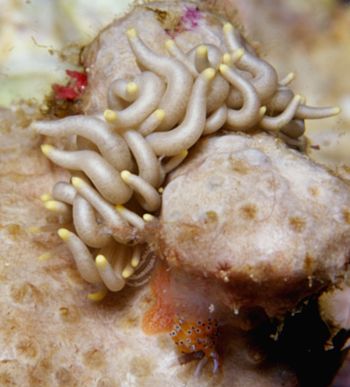
Hi Bill,
I had a double surprise when I looked at this picture from my recent Philippine trip. First I noticed that the Phyllodesmium briareum was laying an egg coil. Then I saw the little orange nudibranch at the bottom of the frame. Terry Gosliner identified the little guy for me as Favorinus tsuruganus. Depth: 8 meters, Length of P. briareum: about 15 mm. Length of F. tsuruganus: about 3 mm
Divesite: Sepok Wall, Batangas, Philippines, May 5, 2001.
Best regards,
Mary Jane
divepng@yahoo.com
Adams, M.J., 2001 (May 26) Phyllodesmium briareum egg laying. [Message in] Sea Slug Forum. Australian Museum, Sydney. Available from http://www.seaslugforum.net/find/4396Thanks Mary Jane,
Not what you would call a very auspicious start to life to have your egg deposited alongside an aeolid nudibranch which specialises in eating opisthobranch eggs. If by chance you have a photo of the egg mass it might be interesting to make a rough estimate of the egg diameter. Large eggs are usually an indication of a species with direct development, in which the free-swimming larval stage is forgone and tiny crawling slugs hatch out of the egg. Some of the coral-eating species of Phestilla have larvae which only spend a few minutes in the plankton before settling down on their host coral colony.
I don't know what happens with any species of the soft-coral feeding genus Phyllodesmium, but Lindsay Warren's message does suggest that P. briareum may be worth following up.
Best wishes,
Bill Rudman
Re: Phyllodesmium briareum from SE Sulawesi
February 21, 2000
From: Lindsay Warren
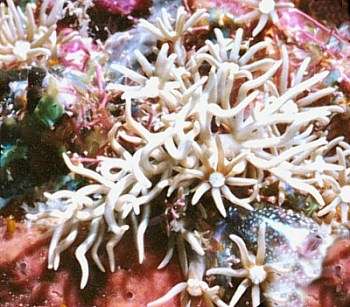
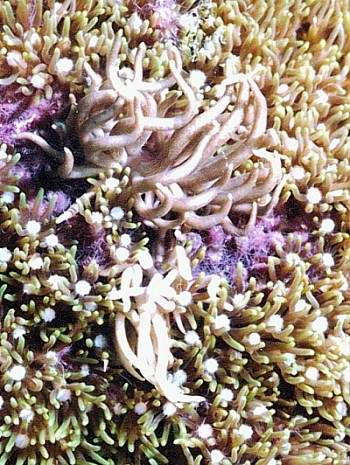
Dear Bill
Thanks for your response on the P. briareum. Unfortunately at the time we were finding large numbers of them my housing was not in operation. When it eventually was, the numbers had dropped quite dramatically so the only shots I have are of pairs. I have attached two shots of these.
Sizes were approximately 12-20 mm at depths of between 25-37 ft where the Pachyclavularia violacea was growing on vertical walls of a lone pinnacle set away from the main reef of Pulau Hoga, one of the smaller islands of the Tukang Besi group. Sadly we did not find any eggs but will be looking out for them in future as usual.
All the best
Lindsay Warren
100014.2112@compuserve.com
Warren, L., 2000 (Feb 21) Re: Phyllodesmium briareum from SE Sulawesi. [Message in] Sea Slug Forum. Australian Museum, Sydney. Available from http://www.seaslugforum.net/find/1936Thanks Lindsay,
Bill Rudman.
Phyllodesmium briareum - direct development?
February 18, 2000
From: Lindsay Warren
Dear Bill
I was wondering whether Phyllodesmium briareum skips the free-floating planktonic stage and develops in the egg case direct to a mini adult form.
In September 1999 [Tukang Besi, SE Sulawesi, Indonesia - Operation Wallacea] we repeatedly found large groups of P. briareum on Pachyclavularia violacea - two groups of 48, another of 67 and then smaller numbers together throughout October and November such as 21. On another occasion towards the end of September I found a group of over 107 in a 90cm x 54 cm area of what looked like Carijoa sp soft coral. Their size ranged from 10 mm - 35 mm. It just seemed a bit odd to think such large numbers of larvae had all been carried by currents to end up in such a small area.
Do you know the answer to this?
All the best
Lindsay Warren
100014.2112@compuserve.com
Warren, L., 2000 (Feb 18) Phyllodesmium briareum - direct development?. [Message in] Sea Slug Forum. Australian Museum, Sydney. Available from http://www.seaslugforum.net/find/1919Dear Lindsay,
I don't know of any studies on the life history of any species of Phyllodesmium. It would be a fascinating exercise and perhaps well worth thinking about as a project next season in Indonesia. If you have any aquarium facilities it may be possible to keep a small colony of the soft coral alive with 2 or 3 Phyllodesmium at least until they produced egg masses which could then be monitored.
Direct development is a possibility, but not necessary to ensure a concentration of young near the prey food. I looked at some species of coral-eating aeolids in fairly primitive conditions in Tanzania and found that they produced lecithotrophic larvae (non-feeding free-swimming larvae) some of which spent only a few minutes swimming before settling down. With one species, in a few weeks, from an original 6 adults I had 2 generations with thousands of eggs all on one small Porites colony. See pages on Phestilla lugubris, Phestilla minor and Cuthona poritophages.
That is not to say that veliger larvae, with a combination of luck and good chemo-sensory ability, are not extremely efficient at finding their preferred food. Another thing to realise as well is that different species of Phyllodesmium may have quite different life-history strategies. It is certainly worth following up if you get the chance.
Bill Rudman.
Rudman, W.B., 2000 (Feb 18). Comment on Phyllodesmium briareum - direct development? by Lindsay Warren. [Message in] Sea Slug Forum. Australian Museum, Sydney. Available from http://www.seaslugforum.net/find/1919Phyllodesmium briareum from Japan
November 29, 1999
From: Rie Nakano
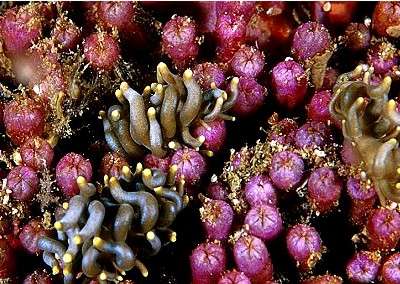
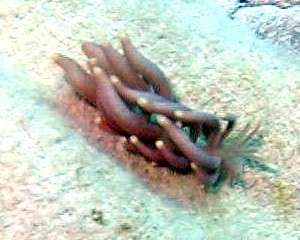
Dear Bill,
This nudibranch is found at Hachijo Island, Japan, by Mr Syouichi Kato.
I found over 10 individuals, They were all on the coral. They look very much like this coral polyp. I have never seen this species except on this Island.
Could you please identify this.
Length: 10-20mm, Depth: 15m, Water temp: 23.6 degrees.
UPPER PHOTO: Rie Nakano
LOWER PHOTO: Ms.K Suzuki
Sincerely,
Rie
rie@street.ne.jp
Nakano, R., 1999 (Nov 29) Phyllodesmium briareum from Japan. [Message in] Sea Slug Forum. Australian Museum, Sydney. Available from http://www.seaslugforum.net/find/1591Dear Rie,
This is the very interesting aeolid Phyllodesmium briareum. Like other species of Phyllodesmium it feeds on soft corals and is certainly very well camouflaged.
It is reported to feed on a number of species of briareid soft coral including Solenopodium stelleri and Briareum stecheri (sensu MacFadyen, 1936). It is also reported from Pachyclavularia violacea a mat forming soft coral with purplish trunks and greenish brown polyps each with a bright white oral disk. From the purple trunks of the soft corals, I suspect that the animals in your photo are on a colony of Pachyclavularia violacea.
The name briareus was apparently given to it by Bergh because of its association with the soft coral Briareum. A good photo of it, and of Pachyclavularia violacea with extended polyps, can be found in Gosliner, Behrens & Williams, (1996) Coral Reef Animals of the Indo-Pacific.
As you will see from the top of the page, P. briareum is one of the species of Phyllodesmium which has a symbiotic relationship with zooxanthella.
Best wishes,
Bill Rudman.
